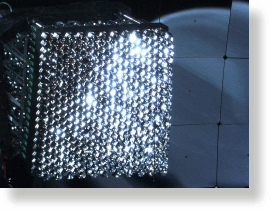|
Design of the front-end electronics for the fluorescence
detector of the AUGER experiment
|
 |
|
|  |
|
P.F. Manfredi, M. Manghisoni, L. Ratti, V. Re, V. Speziali
|
|
|
The AUGER experiment is concerned with the study of cosmic rays with
energies ranging between 1019 and 1021 eV. The extended air
showers produced in the earth atmosphere by cosmic radiation give rise
to fluorescence phenomena, which will be measured by a purposely
developed detection system. In the present design the fluorescence
detector which is to be used in the AUGER experiment is made of 30
modules; each module consists of an array of 20 × 22 photomultiplier
tubes (PMTs).
|

|
|
The front-end electronics employed in the PMTs' readout
is required to preserve time and amplitude information of the original
fluorescence signal, without significantly degrading the noise
performance of the system with respect to the noise level due to sky
background. Furthermore the measurement channel is expected to handle
a 16 bit input dynamic range. After analog processing the waveforms
will be sampled at a rate of 10 MHz with 12 bit resolution. A
compression circuit with bilinear transfer characteristic has been
designed to adapt the dynamic range of the PMT signals to the input
dynamic range of the ADC and to adjust the gain to compensate for the
gain spread of the PMTs. A prototype detector module, consisting of 100
complete channels, have been successfully tested at the end of
2000. In 2001 two modules of 440 channels each have been installed at
the experiment site in Argentina and has begun taking data.
|
|
|
|

